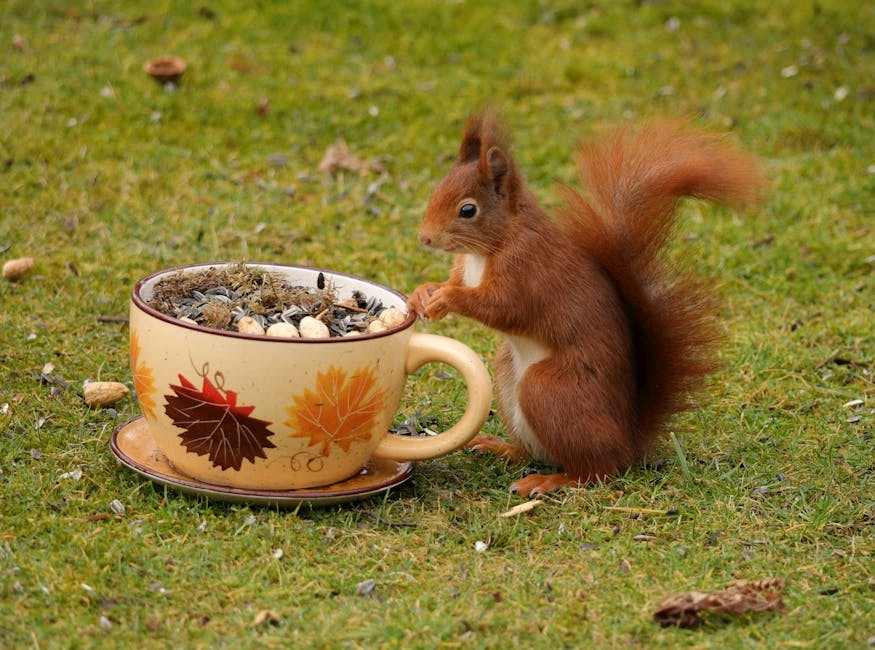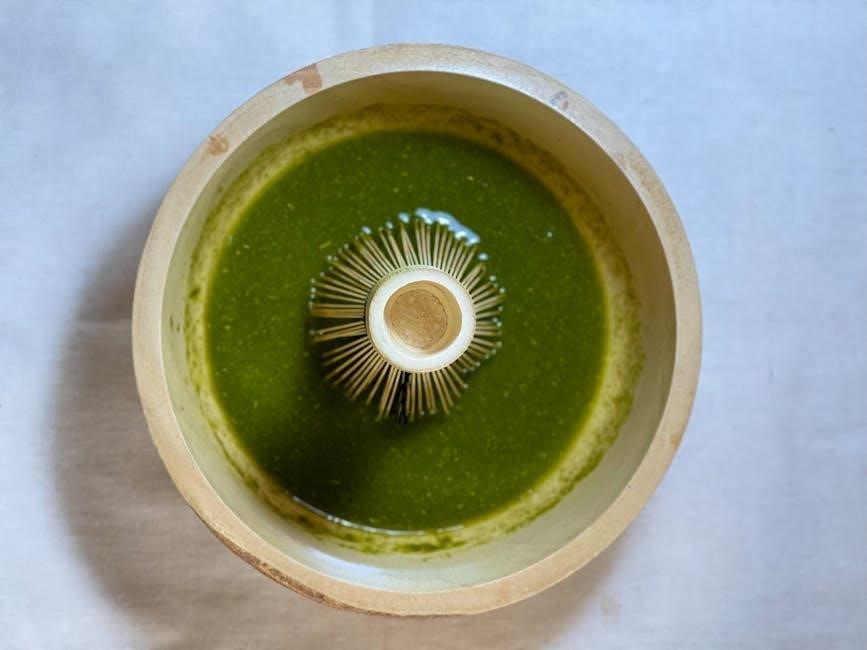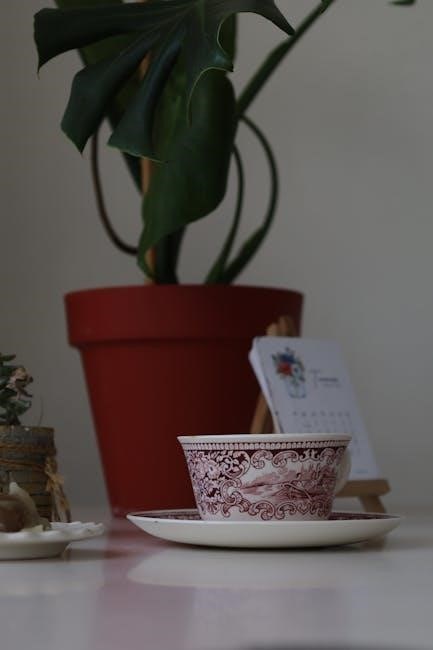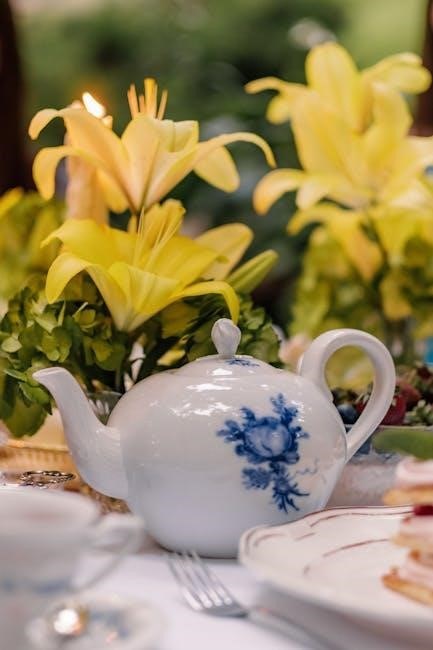Discover the magical journey of raising live caterpillars with the Cup of Caterpillars‚ a hands-on STEM experience. Watch them transform through the fascinating process of metamorphosis. Perfect for educational projects and learning about nature.
Overview of the Cup of Caterpillars Kit
The Cup of Caterpillars Kit is an educational tool designed for hands-on learning about metamorphosis. It includes live caterpillars‚ food‚ and a habitat cup. Perfect for STEM projects‚ the kit allows users to observe the transformation of caterpillars into butterflies. Suitable for children and educators‚ it promotes curiosity and understanding of nature. The kit is easy to use and comes with instructions for care and observation‚ making it a great way to explore the life cycle of butterflies up close.
Understanding the Life Cycle of Caterpillars
The life cycle of caterpillars involves four stages: egg‚ larva‚ pupa‚ and adult. Caterpillars emerge from eggs‚ eat‚ and grow‚ shedding their skin several times. After reaching full size‚ they attach themselves to a surface and form a chrysalis. Inside‚ a dramatic transformation occurs‚ ending with the emergence of a butterfly. Observing this process with the Cup of Caterpillars Kit provides a unique opportunity to witness metamorphosis firsthand‚ fostering a deeper appreciation for nature and biology;

Materials and Supplies Needed
The Cup of Caterpillars Kit includes a cup with live caterpillars‚ food‚ and a lid. Additional supplies like water‚ a clean habitat‚ and optional magnifying tools are recommended.
The Cup and Its Components
The Cup of Caterpillars includes a clear plastic cup with a secure lid‚ designed for easy observation. Inside‚ live caterpillars and their food are provided‚ along with a habitat specifically tailored to their needs. The cup is lightweight‚ durable‚ and safe for handling. Its transparent design allows users to monitor the caterpillars’ growth and development closely. The lid ensures the caterpillars stay contained while maintaining proper airflow. This self-contained system is perfect for home or classroom use‚ offering an engaging and educational experience.
Food and Nutritional Requirements
The caterpillars require a specialized diet provided with the kit‚ ensuring optimal growth and health. This food is nutritionally balanced to support their rapid development. Users should avoid adding external food sources‚ as they may harm the caterpillars. Maintain the cup at room temperature and keep it clean to prevent contamination. Proper feeding is crucial for their transformation into healthy butterflies. Follow the diet instructions carefully to ensure the best results for your Cup of Caterpillars project.
Habitat and Environmental Setup
Creating the right environment is essential for the caterpillars’ growth. Store the cup at room temperature‚ avoiding direct sunlight to prevent overheating. Ensure the habitat remains clean and well-ventilated. If condensation forms‚ open the lid slightly to allow air circulation. Avoid placing the cup near drafts or extreme temperatures. This setup mimics the caterpillars’ natural habitat‚ promoting healthy development. Proper environmental care ensures they thrive and successfully undergo metamorphosis.
Step-by-Step Care Instructions
Maintain the cup at room temperature‚ avoiding direct sunlight. Open the lid if condensation forms. Observe caterpillars as they grow‚ preparing to form chrysalises.
Daily Care and Monitoring
Check the cup daily for condensation and open the lid slightly if needed. Monitor caterpillars’ activity and growth‚ ensuring they remain healthy. Keep the habitat clean by removing frass gently. Maintain room temperature and avoid direct sunlight. Observe as caterpillars progress through stages‚ eventually climbing to the top to form chrysalises. Be patient‚ as initial inactivity is normal. Ensure proper ventilation while keeping the environment stable for optimal development.
Weekly Maintenance Tasks
Clean the cup weekly by gently removing frass and uneaten food. Refresh the habitat by replacing food if necessary. Ensure the cup remains at room temperature and avoid direct sunlight. Check for condensation and adjust the lid as needed. Monitor the caterpillars’ progress‚ noting when they attach to the lid in a J-shape‚ signaling the start of transformation. Maintain a clean‚ stable environment to support their growth and development into healthy butterflies. Regular care ensures a successful metamorphosis process.
Final Stages and Emergence Preparation
As caterpillars attach to the lid in a J-shape‚ their transformation begins. Avoid disturbing them during this critical phase. Ensure the cup is secure and away from drafts. After 7-10 days‚ the chrysalis will form‚ and soon a butterfly will emerge. Keep the habitat moist by lightly misting with water. Once emerged‚ wait 24 hours before releasing the butterfly‚ allowing its wings to fully expand. Prepare a safe‚ outdoor location for release‚ ensuring it’s free from predators and ideal for flight.

Tips for Optimal Care
Maintain room temperature‚ avoid direct sunlight‚ and ensure proper ventilation. Keep the habitat clean‚ and monitor condensation by opening the lid slightly if needed. Be patient!
Best Practices for Handling Caterpillars
Handle caterpillars gently‚ ensuring not to squeeze or disturb them excessively. Wash hands before and after handling to prevent transferring bacteria. Avoid touching caterpillars when they are forming chrysalises‚ as this can disrupt their transformation. Keep the habitat clean and well-ventilated to promote healthy growth. Monitor their activity daily but refrain from over-handling to minimize stress. Provide fresh food and maintain optimal temperature conditions for their development. Observing from a distance can be just as rewarding and ensures their well-being.
Creating a Conducive Environment
Ensure the cup is stored at room temperature‚ avoiding direct sunlight to prevent overheating. Monitor humidity levels and open the lid slightly if condensation forms. Provide fresh food regularly to maintain nutritional balance. Keep the habitat clean by removing frass and uneaten food. Maintain proper ventilation to promote healthy growth. Avoid placing the cup in enclosed spaces to ensure airflow. By creating a stable environment‚ caterpillars will thrive and successfully transition through their life cycle.
Encouraging Healthy Growth and Development
Feed caterpillars fresh‚ appropriate food daily to support growth. Ensure the cup remains clean by removing waste. Maintain proper humidity and temperature for optimal development. Avoid handling caterpillars excessively to prevent stress. Monitor their progress and provide a secure environment. Be patient as caterpillars grow‚ molt‚ and prepare for transformation. These steps ensure a healthy journey from caterpillar to butterfly‚ fostering a successful and educational experience.

Troubleshooting Common Issues
Identify and address common issues such as condensation‚ mold‚ or inactive caterpillars. Ensure proper ventilation‚ clean habitat‚ and adequate nutrition to resolve problems promptly.
Identifying and Solving Health Problems
Monitor caterpillars for discoloration‚ lethargy‚ or unusual behavior. Check for mold or condensation in the cup‚ which can harm their health. Ensure proper ventilation and maintain a clean habitat. If caterpillars are inactive‚ verify room temperature and nutrition. Replace food if spoiled and rinse the cup gently with water. Avoid direct sunlight to prevent overheating. Address issues promptly to ensure healthy growth and successful metamorphosis.
Addressing Environmental Concerns
Ensure the cup is kept at a stable room temperature‚ avoiding direct sunlight and drafts. Maintain proper humidity by monitoring condensation levels. If the cup becomes too moist‚ slightly open the lid to improve airflow. Regularly inspect the habitat for mold or mildew‚ cleaning gently if necessary. Provide fresh food and a clean environment to promote healthy growth and prevent environmental stress on the caterpillars.
Managing Pests or Diseases
Regularly inspect the cup for signs of pests or diseases‚ such as mold‚ dead caterpillars‚ or unusual behavior. Wash hands before handling the habitat to prevent contamination. If mold appears‚ gently remove affected areas and replace food. Ensure proper airflow by slightly opening the lid if condensation builds up. Avoid introducing external materials that may carry pests. If issues persist‚ consult the provided care instructions or contact customer support for guidance on safely resolving the problem.

Educational and Learning Opportunities
The Cup of Caterpillars offers a hands-on STEM experience‚ teaching life cycles‚ metamorphosis‚ and nature. It engages kids in observing transformation processes‚ fostering curiosity and learning.
Understanding Metamorphosis
Metamorphosis is a biological process where caterpillars transform into butterflies. It involves four stages: egg‚ larva‚ pupa‚ and adult. Observing this journey with a Cup of Caterpillars kit provides a unique opportunity to witness this natural wonder firsthand. Children can learn about the fascinating changes‚ from the crawling caterpillar to the emergence of a beautiful butterfly‚ making it an engaging educational experience.
Teaching Children About Nature
Exploring a Cup of Caterpillars offers a fun and interactive way to teach children about nature. This hands-on experience fosters curiosity and a connection to the environment. Kids can learn about life cycles‚ observe metamorphosis‚ and understand the importance of ecosystems. It encourages STEM learning and nurtures a sense of responsibility through caring for the caterpillars. This activity is perfect for sparking an early interest in science and the natural world‚ making learning both engaging and memorable.
Incorporating STEM Concepts
The Cup of Caterpillars kit seamlessly integrates STEM concepts‚ offering a hands-on learning experience. Science is explored through observing metamorphosis‚ while technology and engineering inspire creative habitat designs. Math skills are developed by tracking growth stages and measuring progress. This interactive project fosters critical thinking‚ scientific observation‚ and problem-solving‚ making it an engaging way to introduce children to essential STEM principles in a fun and educational manner.

Safety Precautions and Considerations
Always handle caterpillars gently to avoid harming them. Wash hands before and after handling. Store the cup away from direct sunlight and extreme temperatures to ensure a stable environment.
Handling Caterpillars Safely
Handle caterpillars gently to avoid injury. Wash hands thoroughly before and after touching them. Avoid sudden movements or squeezing‚ as this can harm the caterpillars. Keep them away from direct sunlight and extreme temperatures. Never touch your eyes or face after handling caterpillars. Store the cup securely to prevent accidental spills or damage. Ensure children are supervised during handling to maintain safety for both the caterpillars and the handler. Clean the cup regularly to maintain a healthy environment.
Allergies and Sensitivities
Some individuals may experience allergies or sensitivities when handling caterpillars or their habitats. Common reactions include skin irritation or respiratory issues. If you or a child has a known allergy to insects or related products‚ consult a healthcare professional before interacting with the Cup of Caterpillars. Wear gloves if sensitivity is a concern and avoid touching face or eyes. Ensure the environment is clean and well-ventilated to minimize potential allergic responses.
Secure Storage and Handling
Store the Cup of Caterpillars in a secure‚ upright position to prevent spills. Keep it away from direct sunlight and extreme temperatures. Handle the cup gently to avoid disturbing the caterpillars. When not in use‚ ensure the lid is tightly closed to maintain humidity and prevent contamination. Avoid placing the cup near pets or children who may mishandle it. Clean hands before and after handling the cup to ensure a safe environment for the caterpillars to thrive.

Creative and Fun Activities
Engage in crafts‚ storytelling‚ and interactive games inspired by caterpillars. Transform simple materials into playful crafts‚ fostering creativity and curiosity about their life cycle and transformation.
Crafts Inspired by Caterpillars
Transform simple materials into playful crafts‚ like a DIY caterpillar on a leaf. Use paper folding techniques to create caterpillar body segments or paint circles for a colorful caterpillar art project. Kids can trace and stamp handprints in green paint to mimic caterpillar movements. These activities foster creativity and curiosity about the life cycle of caterpillars‚ making learning fun and engaging for all ages.
Storytelling and Art Projects
Engage in creative storytelling by illustrating the life cycle of caterpillars through art. Draw their transformation from tiny larvae to beautiful butterflies‚ using vibrant colors to capture each stage. Craft a caterpillar-themed journal to document observations and imaginative tales. Combine art and storytelling to create a visual narrative of their journey‚ fostering creativity and a deeper connection to nature.
Interactive Learning Games
Make learning fun with interactive games that complement the Cup of Caterpillars experience. Create a “Caterpillar Life Cycle Match” game to teach metamorphosis stages. Use flashcards to identify different species and their habitats. Design a “Butterfly Migration” board game to simulate their journey. Incorporate crafts‚ like tracing caterpillar shapes or stamping leaf patterns‚ to engage creatively. These activities foster curiosity and hands-on learning‚ making the experience enjoyable and educational for all ages.

Environmental Considerations
Consider the eco-friendly aspects of raising caterpillars‚ ensuring their release doesn’t harm local ecosystems. Promote sustainable practices and responsible butterfly releases to maintain environmental balance and biodiversity.
Impact on Local Ecosystems
Raising caterpillars can have unintended effects on local ecosystems if not managed properly. Releasing non-native butterflies may disrupt native species and ecological balance. Ensure responsible practices to avoid harming local wildlife and vegetation.
Research local regulations and ensure the species you release are native to your area. Avoid introducing invasive species‚ as they can cause significant environmental damage and outcompete native organisms for resources;
Sustainable Practices
Adopt eco-friendly habits when caring for your Cup of Caterpillars. Use recyclable materials for habitats and minimize waste. Conserve resources by efficiently using food and water. Avoid harmful chemicals to protect the environment and ensure the health of your caterpillars. Encourage composting of organic waste to reduce your ecological footprint and promote sustainability in your community.
Responsible Release of Butterflies
Releasing butterflies responsibly ensures their safe integration into the environment. Wait until they fully emerge and dry their wings before release. Choose a location with suitable food sources and shelter‚ avoiding areas with predators or pesticides. Release them in the morning or late afternoon for optimal survival. Avoid introducing non-native species to protect local ecosystems. This practice supports biodiversity and promotes ecological balance‚ giving your butterflies the best chance to thrive and contribute to nature.

Cultural and Historical References
Caterpillars hold symbolic meanings in various cultures‚ representing transformation and renewal. Historically‚ they’ve been featured in myths‚ folklore‚ and traditional beliefs‚ often symbolizing growth and natural cycles.
Cultural Significance of Caterpillars
Caterpillars have captivated cultures worldwide‚ symbolizing transformation and renewal. In mythology‚ they often represent patience and growth. Historically‚ they’ve been featured in folklore and traditional beliefs‚ embodying the cycle of life. Their unique life cycle has inspired artistic and literary works‚ while their presence in educational tools like the Cup of Caterpillars fosters curiosity and learning about nature. This cultural fascination continues to inspire both children and adults‚ blending science with storytelling.
Historical Uses and Beliefs
Caterpillars have held symbolic and practical significance across cultures. Ancient societies viewed them as symbols of transformation and renewal‚ often linking them to myths of patience and growth. Some cultures believed caterpillars possessed medicinal properties‚ while others saw them as omens or symbols of caution. Their life cycle has inspired folklore‚ with stories emphasizing the balance between beauty and caution. Historically‚ caterpillars have also been subjects of fascination in art and literature‚ reflecting their unique role in nature and human imagination.
Modern Cultural References
In contemporary culture‚ caterpillars appear in children’s media‚ like the Hungry Caterpillar in Eric Carle’s books. They’re also featured in films and games‚ symbolizing growth and transformation. The Cup of Caterpillars kit has become a popular educational tool‚ fostering STEM learning and environmental awareness. Social media often highlights their fascinating metamorphosis‚ inspiring creativity and curiosity about nature. These references reflect a blend of education‚ entertainment‚ and the enduring charm of these tiny creatures in modern society.
Raising caterpillars offers a rewarding journey of discovery‚ teaching patience and wonder. Witnessing their transformation fosters a deeper appreciation for nature and life cycles.
Reflecting on the Experience
Reflecting on raising caterpillars reveals a journey of growth‚ wonder‚ and responsibility. Observing their transformation from tiny larvae to majestic butterflies is deeply fulfilling. This hands-on experience fosters curiosity‚ patience‚ and a connection to nature. It also highlights the beauty of metamorphosis‚ offering insights into the life cycle of insects. Many find the process therapeutic and educational‚ making it a cherished memory for both children and adults.
Long-Term Benefits and Learning
Raising caterpillars offers lasting educational benefits‚ teaching life cycles‚ patience‚ and environmental stewardship. It encourages STEM exploration and fosters a deeper appreciation for nature. This experience also enhances observational skills and responsibility‚ providing a unique opportunity to witness metamorphosis firsthand. Many participants develop a lifelong interest in entomology and conservation‚ making it a valuable learning experience for all ages.

Additional Resources and Support
Explore Insect Lore’s official website for detailed guides and troubleshooting tips. Engage with community forums for shared experiences and expert advice on raising caterpillars successfully.
Recommended Reading and Websites
For comprehensive guides‚ visit Insect Lore’s official website‚ offering detailed care instructions and troubleshooting tips. Explore community forums for shared experiences and advice. Check out educational websites like ButterflyLifeCycleKit.com for interactive learning tools. Recommended books include Raising Butterflies: A Complete Guide and The Magic of Metamorphosis. Additionally‚ subscribe to STEM-focused platforms for hands-on activity ideas and scientific insights to enhance your learning journey with Cup of Caterpillars.
Community Forums and Groups
Engage with online communities like Insect Lore’s forums for shared experiences and advice. Join discussion groups on platforms like Facebook or Reddit‚ where enthusiasts exchange tips and troubleshooting solutions. Participate in STEM-focused forums to connect with educators and hobbyists. These spaces offer valuable insights‚ photo updates‚ and creative ideas for your Cup of Caterpillars project. Sharing your journey and learning from others enriches the educational experience and fosters a sense of community among caterpillar caretakers.
Customer Support Contacts
For assistance with your Cup of Caterpillars‚ contact Insect Lore’s customer support at info@insectlore.co.uk or visit their website at InsectLore.co.uk. Their dedicated team provides guidance on care‚ troubleshooting‚ and ordering replacement cups. Additionally‚ explore helpful FAQs and resources available online to ensure a smooth and successful experience raising your caterpillars.